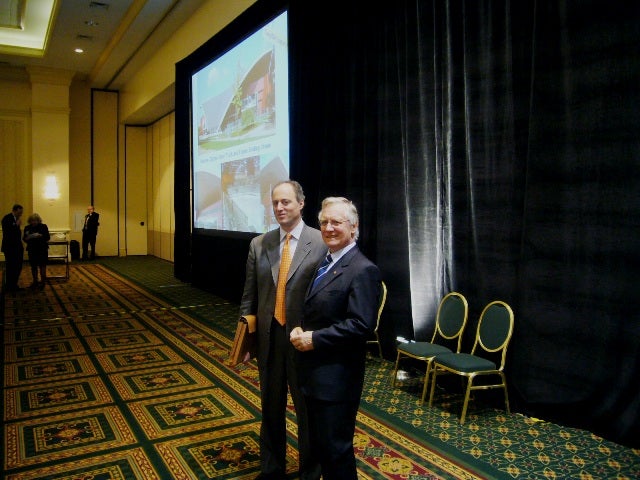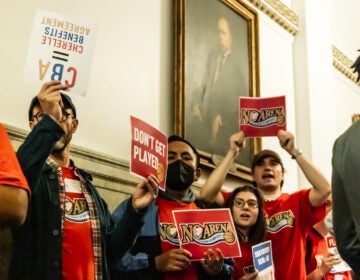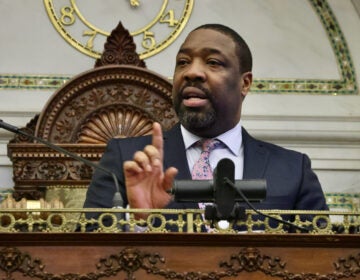So how does place matter?

Deputy Philadelphia mayor Andrew Altman and former Torino mayor Valentino Castellani
March 26
By Thomas J. Walsh
For PlanPhilly
We live in a metro nation, and the key to American prosperity in the 21st century might start with a new, realistic awareness of how the United States is geographically constituted, said Bruce Katz, vice president and director of the Metropolitan Policy Program at the Brookings Institution in Washington D.C.
Katz was the opening speaker at a three-day city planning conference that kicked off Wednesday morning at the Philadelphia Marriott. Sponsored by the Federal Reserve Bank of Philadelphia, the gathering is titled, “Reinventing Older Communities: How Does Place Matter?”
In his presentation, “A Blueprint for American Prosperity: Unleashing the Potential of U.S. Cities and Metro Areas,” Katz excoriated the status quo of the country’s political dialogue. When it comes to revitalizing urban areas, he said, it’s not even a matter of the wrong priorities. The biggest problem is that metro areas are not discussed at all, in a country where the overwhelming majority of the population – about 65 percent – lives in what he describes as hundreds of metro areas.
“Metro areas are less than the sum of their parts, politically,” he said. “We are not organized. We still live in a 1970s world of city versus suburb. What we need to re-imagine is a different kind of politics, when the top 50 metro areas assert their needs with more clarity.”
Katz said it’s absurd that the nation persists in viewing itself as something from our pastoral past. Even in Iowa, more than half the state is considered metropolitan. Yet presidential hopefuls must be seen at county fairs, eating the local fried foods, to be considered down-to-earth, he said. In New Hampshire, the metro total is 69 percent.
“Why are we not having this conversation?” he said. Who we are as a nation has been distorted in the public discourse, Katz argues, and to compete in a global economy, the U.S. can’t do it city-by-city or state-by-state. Instead of 50 states, we need to think more in terms of the country’s 363 metro areas.
Despite the content of his message, Katz was generally upbeat, and expressed confidence that the current presidential election will galvanize the kind of discussions that will lead to a reversal of the country’s “fragmented” state of innovation. He cited Mayor Michael Nutter, who addressed the crowd of about 500 to start the conference, as an example of a politician who displayed guts and was rewarded at the polls.
Andrew Altman, Nutter’s new Commerce Department director and the head of the Philadelphia City Planning Commission, introduced Katz.
A history of reinvention
Valentino Castellani, a former mayor of Torino, Italy, said that sometimes, being a little lucky helps when it comes to turning things around. Castellani spoke after Katz and described the various ways that his city reinvented itself after a period of economic and political turmoil, culminating in the hard work – and more than a little luck – that brought the 2006 Winter Olympics to Torino.
“A crisis causes problems and [a] depression, but also opportunity to change and innovate,” Castellani said. “It is important to identify and share the city’s strengths. Planning must be done through a bottom-up process.”
Though Torino, or Turin, has about 2,000 years on Philadelphia and sits amid pristine alpine vistas, the two cities had some things in common during the 20th century. Torino’s economy was mostly industrial, led by car companies, Fiat chief among them. When that industrial base declined, so did the population. Discontent and Philly-style corruption ensued. In the period between 1986 and 1993, there were four mayors, and the Italian parliament had to step in to bring about reform. Castellani was mayor from 1993 through 2001.
Place does indeed matter, Castellani said, and during his time in office, a movement to take advantage of the city’s location as the gateway to Northern Europe and the Alps, on the border with France, was launched. Being awarded the ’06 Olympics was a turning point for the city, fostering “a new pride in affiliation” among the citizenry and shepherding large, concentrated amounts of capital into improvement projects.
But the Olympics, as significant as the games were to the town, were not the end of the city’s planned turnaround.
“The transition that we started to plan in the early ’90s will end in 2020,” Castellani said. “You have to keep alive the vision of the future.”
Penn’s expansion
Amy Gutmann, president of the University of Pennsylvania, gave the luncheon address Wednesday.
Gutmann enthusiastically outlined plans for 24 acres of land purchased from the U.S. Postal Service along the Schuylkill River, within the aegis of the school’s Penn Connects project. Within a few years, hundreds of millions of dollars will be deployed on the creation of open recreational space and new research and technology buildings.
The plans include a new pedestrian bridge over the river and “an entire transformation of Walnut Street,” she said.
Thursday’s morning session will address the role of philanthropy in changing neighborhoods, as market-based redevelopment plans are increasingly driven by foundations or wealthy individuals.
A 32-minute video of Katz’s presentation, taped in November, can be seen here: http://www.brookings.edu/multimedia/video/2007/1106_blueprint.aspx
An English-language Web site for the city of Torino: http://www.comune.torino.it/en/
Penn Connects: http://www.pennconnects.upenn.edu/
Contact the reporter at thomaswalsh1@gmail.com
WHYY is your source for fact-based, in-depth journalism and information. As a nonprofit organization, we rely on financial support from readers like you. Please give today.






